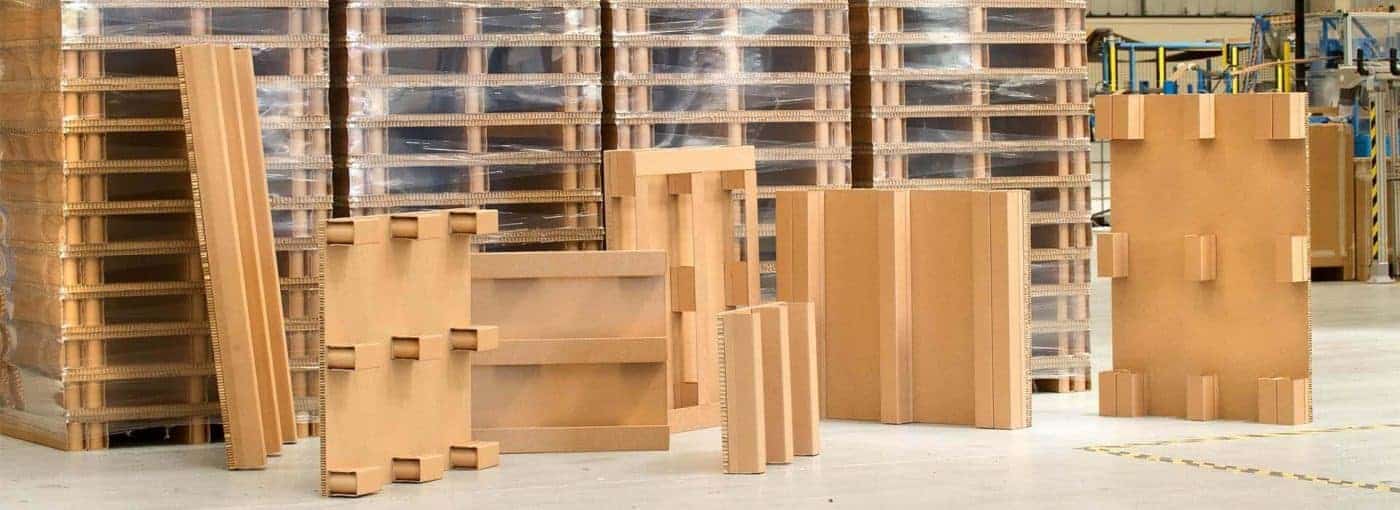Shipping pallets are an essential part of global freight. In fact, as of 2022, there are more pallets in use across Europe than there are people. Traditionally made from wood, plastic and metal, hundreds of thousands of pallets are produced each year as international trade continues to grow. However, in an age in which businesses of all industries are trying to become more efficient through the use of more sustainable materials and products, could cardboard pallets soon become an industry staple?
In this blog, PALLITE® will explain the fundamentals of pallets, and the various types available – including increasingly popular cardboard pallets. We will then focus on the many benefits of these sustainable pallets, as we take a deeper look at this humble warehouse staple.
What is a pallet?
Pallets are basically-constructed horizontal platforms used to make the transportation of heavy goods and large bulk shipments safer, quicker and more efficient. Typically built from two ‘decks’ with a gap in the middle, pallets are designed to provide a strong and sturdy base for goods, while lifting them up off the floor so they can be easily picked up and manoeuvred using forklift trucks and hand pallet trucks.
What are cardboard pallets?
Cardboard pallets are simply shipping pallets that are manufactured from sheets of paper or card glued together, rather than wood or plastic. Typically, these sustainable pallets – such as those in PALLITE®’s range of paper-based shipping pallets – are made using a structural grade, water resistant Kraft paper outer for the top and bottom decks with a 10mm cell recycled honeycomb paper core
How big are pallets?
Although pallets can be built to order using bespoke measurements, there are a number of standardised pallet sizes that are recognised within the freight shipping industry. However, even among these recognised norms, standard pallet sizes also differ according to geography. For this reason, it is important to understand which type of pallet you want before making a purchase.
In the US and UK, the standard pallet size is 120cm by 100cm (48″ x 40″). However, standardised European (Euro) pallets are usually smaller, at 120cm by 80cm (48″ x 31″). That said, most pallet suppliers, including PALLITE®, stock both US/UK and Euro pallets.
What are the different types of pallets?
Although pallets are now manufactured using a range of different materials, as discussed above, there are also different types of pallets, the four most common of these are:
– Block pallets
Also known as four-way entry pallets, block pallets have gaps for forklift prongs on all four sides, making them easy to manoeuvre. Traditionally made from wood, but also available in plastics, metal and paper-based honeycomb cardboard, these common pallets are available both with and without bottom boards.
– Stringer pallets
Stringer pallets are made up of either two or four boards that run between the top and bottom decks. These boards connect the decks and allow the pallet to form a sturdy platform that can support a payload. Unlike block pallets, however, two-way stringer pallets only allow fork lift entry from two sides.
– Double-face pallets
Although the vast majority of pallets are made up of two decks, most are single-face. This means that they have a defined top and bottom deck and can only be used one way up. Double-face pallets, on the other hand, are composed of top-facing decks on both the top and bottom. This means they can be used either way up and goods can be stacked on either side, making them a more versatile and sturdy pallet option.
– Solid deck pallets
As the name suggests, unlike traditional pallets consisting of top deck surfaces made up of several individual planks, solid deck pallets comprise of one large sheet of wood, metal, plastic or cardboard to form their top surface. Considered more aesthetically pleasing and easier to clean than traditional pallets, solid deck pallets are designed to take all types of consignments, big or small.
(H3) Advantages of sustainable pallets
There are a range of benefits associated with changing to sustainable pallets, such as those made from cardboard, rather than traditional wooden, plastic or even metal pallets. These include:
– They can be recycled
Paper pallets are made from 100% recyclable materials. While standard wooden pallets will need disposing off correctly when they can no longer be used (which can be costly), paper pallets can be easily recycled by both businesses and consumers alike. This not only creates a new potential revenue stream for your business and holds reputational benefits, it is also better for the environment.
– Lightweight yet strong
Although they can be weakened by prolonged exposure to water, cardboard and paper pallets can be designed to be strong enough to hold the same weight as their wooden counterparts, while also being as much as 80% lighter. This also means freight costs can be reduced as overall payloads will weigh less. For example, you could save as much as £60 per pallet when sending via air freight.
– Decreased risk of contamination
Paper based pallets do not use nails and cannot produce splinters like wooden pallets, reducing the risk that goods can be contaminated.
– ISPM15 Exempt
ISPM 15 governs wood packaging, including pallets, and requires that wood pallets be treated in a manner that prevents infestation and the transfer of insects and other organisms as they move through the international supply chain. However, ensuring that wooden pallets are properly treated is an extra expense and hassle for manufacturers and distributors who provide pallets for export. They may instead wish to bypass ISPM 15 by using pallets made of a material besides wood. Pallets made of paper, for instance, are exempt from ISPM 15 regulations so don’t require treatment and won’t harbour insects.
If your business is looking to introduce more sustainable solutions for your supply chain, be sure to check out the entire PALLITE® range of honeycomb paper-based cardboard pallets, shipping crates and other similar products such as layer boards
